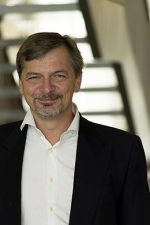
Lars-Oliver Essen, Professeur à la Philipps-Universität de Marburg est invité par le Laboratoire PASTEUR du Département de Chimie de l’ENS durant le mois de septembre 2016. Son équipe d’accueil est le Groupe de Photochimie Ultrarapide.
Lars-Oliver ESSEN donnera, en qualité de Professeur invité au département de chimie de l’ENS les trois cours suivants :
15/09: Photorécepteurs : Classes, fréquence et fonctions biologiques.
22/09 : Photorécepteurs : Relations structure-fonction dans les photorécepteurs biologiques et bases mécanistiques.
29/09 : Photorécepteurs : Optogénétique, de la structure à l’application.
Ils auront lieu au 29 rue d’Ulm en salle Paul Langevin (1er étage, couloir de gauche) les jeudis 15, 22 et 29 septembre, de 14h à 16h.

More information on his research :
We use protein crystallography, biophysics and protein chemistry in the following three topics: photobiology, ion-channel engineering and fungal cell wall architecture.
Photobiology: Coming initially from membrane protein crystallography, where we analyzed structures of light-driven ion pumps, we set out to study the molecular mechanism of DNA repair by photolyases. This class of enzymes is indispensable for most sun-exposed organisms to maintain genomic integrity despite damages caused by UV light. Our structures of class I and II photolyases complexed to UV-damaged DNA demonstrate that repair of genotoxic UV-lesions depends on the direct, UV/blue light-driven injection of an electron onto the lesion when bound next to the flavin chromophore. Class II photolyases, present in all plants and most animals, deviate significantly from class I enzymes, raising the question, how the repair of UV-lesions within chromatin-packaged DNA proceeds. We expect that these studies could pave a way to UV-harden domestic plants and livestock.
Phytochromes are not only light switches for plant development, e. g. shade avoidance, but also occur in many photosynthetic and non-photosynthetic eubacteria. Our work on cyanobacterial phytochromes proved that red-light signaling, as exerted by plants, employs a very complex environment for controlling the photoreactivity of their bilin chromophore. Ongoing efforts focus on the nature of structural changes required to mediate down-stream signaling by plant and bacterial phytochromes.
Based on these structural & biochemical data we engineer novel optogenetic tools for exerting light-control on signaling, gene expression or catalysis.
Ion channel engineering: Inspired by the advent of light-controlled channelrhodopsins, ion channels have found wider application in basic sciences like neurobiology. We use wide-pore channels derived from bacterial and mitochondrial porins like OmpF, OmpG and VDAC to reengineer them chemically in terms of specificity and switching characteristics.
Other projects deal with fungal cell wall architecture & adhesion and may hence become relevant for human health and biotechnology. By analyzing the structures and properties of fungal adhesion domains, we showed so far the structural base of flocculation by baker’s yeast, a process important e. g. in beer brewing. Another example, our work on the related Epa protein family from Candida glabrata, an opportunistic human pathogen, may trigger the development of anti-adhesive antimycotics.
Lars-Oliver Essen
